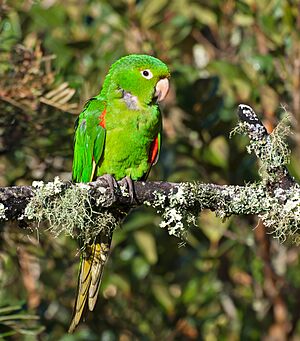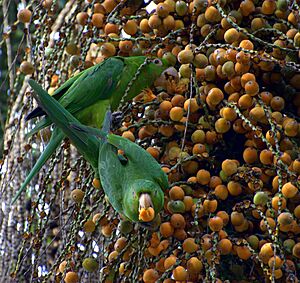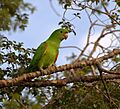White-eyed parakeet facts for kids
Quick facts for kids White-eyed parakeet |
|
|---|---|
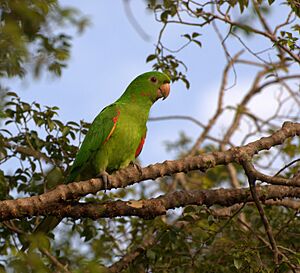 |
|
| In Piraju, Brazil | |
| Conservation status | |
| Scientific classification | |
| Genus: |
Psittacara
|
| Species: |
leucophthalmus
|
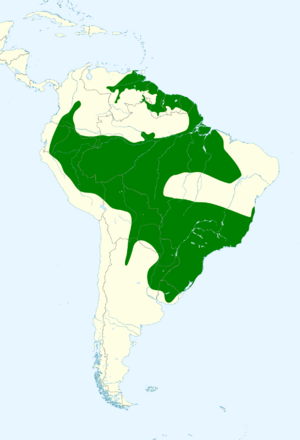 |
|
| Synonyms | |
|
|
The white-eyed parakeet (Psittacara leucophthalmus), also called the white-eyed conure by bird lovers, is a type of parrot. It belongs to the Psittacidae family, which includes parrots from Africa and the Americas. You can find this bird in most countries in South America, except Chile, and also on the island of Trinidad.
Contents
What is a White-Eyed Parakeet?
The white-eyed parakeet is a medium-sized parrot. It measures about 32 to 35 centimeters (12.5 to 14 inches) long. Its wingspan is around 37 to 40 centimeters (14.5 to 15.5 inches). These birds usually weigh between 100 and 218 grams (3.5 to 7.7 ounces). Both male and female parakeets look alike.
Appearance of the White-Eyed Parakeet
Most of the white-eyed parakeet's body is green. The green color is lighter on its belly. They have small red spots on their head and neck. The front edge of their wings also has red markings. The feathers under their wings are yellow and red. The underside of their flight feathers and tail are olive green.
Their eyes are orange and surrounded by a patch of bare white or yellowish-white skin. This gives them their "white-eyed" name. Their beak is a horn color, which is a pale yellowish-brown. Young parakeets look similar to adults but have less red on their heads and wings.
Where White-Eyed Parakeets Live
White-eyed parakeets live in many different places. They are found in eastern Venezuela, the Guianas, and south through Brazil. Their range extends into Bolivia, Paraguay, northern Argentina, and Uruguay. One type of this parakeet lives in southeastern Colombia, Ecuador, and northwestern Peru.
Habitats of the White-Eyed Parakeet
These birds like open areas. They live at the edges of thick forests and in nearby grasslands. You can also find them in forests that are growing back after being cut down. They live in areas with palm trees and mangrove swamps. They are usually found in lowlands. However, they can live at higher elevations in some countries, like Bolivia.
White-Eyed Parakeet Behavior
White-eyed parakeets often gather in large groups. These groups can have hundreds of birds. Sometimes, they even join flocks with other types of parrots. They sleep together in trees, cane fields, and caves.
What White-Eyed Parakeets Eat
The main food for white-eyed parakeets is fruit. They also eat seeds, flowers, and a few small insects. They sometimes visit "clay licks," which are places where animals eat soil to get minerals.
Reproduction and Life Cycle
The breeding season for white-eyed parakeets changes depending on where they live. They build their nests in holes found in trees and palm trees. A female parakeet usually lays three to four eggs. In captivity, the eggs hatch after about four weeks. The young birds are ready to fly about nine weeks after hatching.
Sounds of the White-Eyed Parakeet
White-eyed parakeets are very noisy birds. When they fly, they make loud, chattering sounds. These sounds can be described as "r'teet-r'teet-tiw-". They also make sharp, squeaky notes and harsh calls, like "scree-ah".
White-Eyed Parakeets as Pets
White-eyed parakeets are not as colorful as some other parakeets. However, they can make sweet, friendly, and talkative pets. They usually do not cause much damage around the house. They are also not known for being very loud screamers. Instead, they often learn to copy human speech.
Some bird breeders like to raise white-eyed parakeets. This is because these birds are good at taking care of their young. They usually start nesting in March or April. They can lay about four eggs in a clutch. Young parakeets might start talking when they are very young. Most of them will be able to talk by the time they are six months old.
White-eyed parakeets can sometimes be mistaken for Finsch's parakeets. Both have red and yellow patches under their wings. However, adult white-eyed parakeets do not have a red triangle on their forehead. In captivity, these birds can live for 25 to 30 years.
Images for kids



